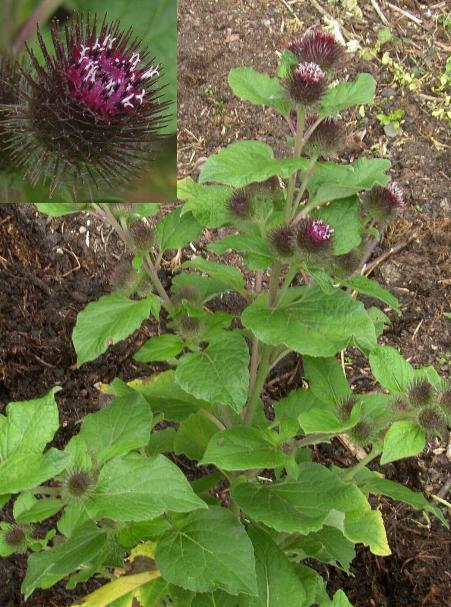Lesser BurdockScientific Name: Arctium minus |
Lesser Burdock is a biennial plant closely related to the thistles, found on roadsides, woodland edges and waste ground. It is native to Europe, but has been spread to other regions, probably because of its medicinal and culinary uses. In its first year it grows as a basal rosette, then in the following year multiple branched stems arise and can reach up to 1.5 metres.
The dark green leaves are ovate with a fine grey down on the underside. The lower leaves are heart-shaped, have a wavey edge and can be up to 50cm long.
The compound flowers are produced in the second year from July to October and have purplish petals in the centre with prickly bracts surrounding the head. After maturing the hooks on the bracts attach the dried seedheads or burrs to the fur of passing animals for dispersal.
George de Mestral is said to have invented Velcro after examining the burrs which became attached to his clothes and his dog's fur while out walking.
The deep, fleshy root is usually branched and has had many culinary and medicinal uses in the past. Probably the best known use is in a Dandelion and Burdock drink which dates back to the thirteenth century, made from lightly fermented extracts of the roots. It is best harvested in its first year or in the spring of the following year. The roots are high in fibre with vitamin B and minerals, and when roasted have been ground to brew into a coffee substitute. Young shoots and peeled roots have been cooked and eaten as a vegetable in Scotland.
Burdock has anti-bacterial and anti-fungal properties with uses in treating colds, sore throats, abscesses and tonsillitis. Used externally it can sooth skin conditions. It can eliminate heavy metals so is used to de-toxify the blood in Chinese medicine. In large doses it can cause seizures and is contraindicated during pregnancy and lactation as it interferes with iron uptake and has diuretic effects. Lithium therapy, diabetic and anti-inflammatory drugs are also affected.
Essiac is blend of herbs used by alternative therapists to treat cancer and other illnesses, and Burdock is one of the ingredients.
The root can be easily loosened with a fork, especially in the first year.
Use a systemic or selective weedkiller when the foliage is growing well in mid-summer and repeat the following spring if new leaves appear.
